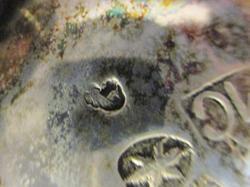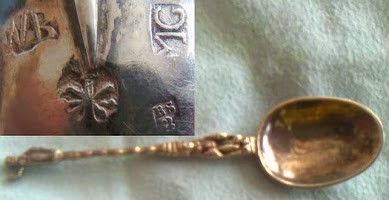Hi, welcome to the forum.
your image

Dutch pseudo/fake or so called fantasy mark.
For Dutch hallmarks see:
http://www.925-1000.com/forum/viewtopic.php?f=5&t=32028
For Dutch maker’s marks and pseudo marks see:
http://www.925-1000.com/forum/viewtopic.php?f=5&t=28590
Turn of the 19th century antique silver with the old guild marks are in high demand at home and abroad. Some well-known Dutch silversmiths applied pseudo or fantasy marks, as part of the decoration, to give their silver work an antique look and with proper Dutch (hall) marks and maker's mark.
 RS above 2 for: Jans Rinze Spaanstra registered in the cities of Drachten/Wommels/Berlicum(Frisian) and Nijehaske from around 1843 till 1896. Known to have used those particular set of pseudo marks see: http://www.925-1000.com/forum/viewtopic ... 568#p85568
RS above 2 for: Jans Rinze Spaanstra registered in the cities of Drachten/Wommels/Berlicum(Frisian) and Nijehaske from around 1843 till 1896. Known to have used those particular set of pseudo marks see: http://www.925-1000.com/forum/viewtopic ... 568#p85568
Seen on spoons, the well known pseudo marks; VB and MC both pseudo maker‘s mark, single headed eagle pseudo city mark for Deventer.
Please check your tea set for proper Dutch marks and a maker's mark, these marks could be tiny and spread over the item.
I believe I do recognize a Dutch tax mark:
 The Dolphin mark
The Dolphin mark
The Dutch dolphin mark; the 1859 duty mark for new unguaranteed objects of national origin. This mark was used on all new silver objects below legal standard of fineness, those with non-precious metal additions, and on new heavily gold or silver plated objects, as long as the average precious metal content after melting with the base metal was at least 250/1000. It was also struck on rejected objects which had been submitted at lowest standard of fineness. In that case the maker had to choose between destruction or ‘unguaranteed’ marking. This mark was sometimes also mistakenly used on old and foreign objects. Dolphin mark used from 1859-1893 and valid from 1859 till 1953.
Oel
















